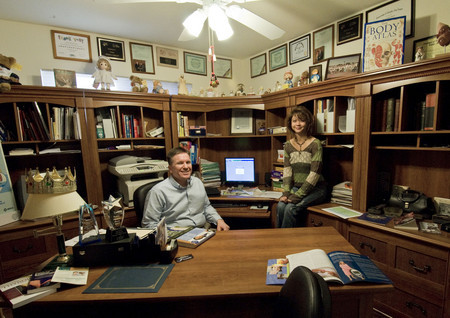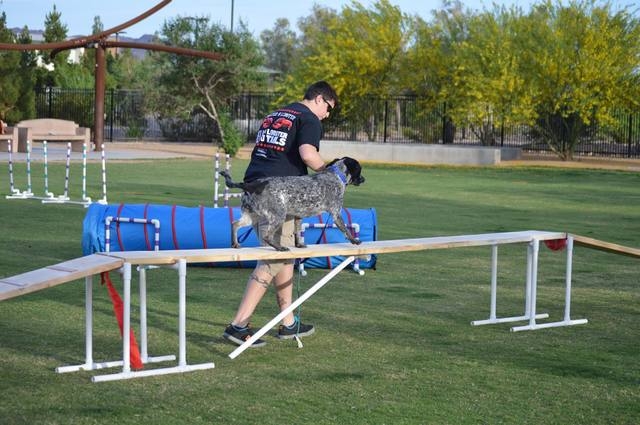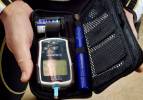Couple take diabetes personally, open hearts to support groups
The nurse who entered Carolyn Moore's Las Vegas home found her on the floor.
Mouth-to-mouth resuscitation couldn't bring her around.
Nearly five years later, the memory of that day, when his mother died, makes it almost impossible for the nurse to talk.
"I'm sorry," Chris Moore said, his voice quavering. "I was a self-described mama's boy. I loved her so much. She had long ago given me the passion to help people. I just don't want to see anybody else go through what she did."
Moore, a critical care nurse at Valley Hospital Medical Center, and his wife, Theresa, an emergency room nurse there, recently discussed how they came to head the largest educational diabetic support group in Nevada. They also play a key role in an Internet program that has caught the attention of diabetics worldwide.
"My mother had every kind of complication from diabetes you could have, and that's what she died of -- bad heart, kidney failure, failing eyesight, open ulcers in the feet," Chris Moore, 39, said outside his home in southwest Las Vegas. "And my wife has had diabetes ever since she was a little girl. We do what we do because we take this disease personally. We want people with diabetes to still be able to live a good, long happy life."
The Moores don't take a dime for managing the Adult Diabetes Education and Support Group, which meets the second Sunday of each month at the West Charleston Library.
"That's not who we are," said 35-year-old Theresa Moore. "We simply see a need for education in diabetes that continues to grow."
They also provide much of the information for diabetes education podcasts offered through diabetespowershow.com, a Web site that has received nearly 5 million hits since its inception a little more than two years ago.
Nearly 24 million people in the United States, about 8 percent of the population, have diabetes, which is the seventh leading cause of death in the country.
When she was 12, Theresa Moore became one of the estimated 13,000 youngsters who each year develop Type 1 juvenile diabetes.
This type occurs when the pancreas stops making insulin, which helps keep the amount of sugar in the blood at a stable level. It is a lifelong disease that requires a highly structured regimen of diet modification, exercise and insulin injections to manage.
But what has caught the most media attention in recent years is Type 2 diabetes, in which the body still produces adequate amounts of insulin but tissues in the body are insensitive to it.
Known as insulin resistance, this condition is seen increasingly in people whose physical activity is low and have high body fat levels.
Once it is diagnosed, it is best treated with improvement in diet and fitness.
Twenty years ago, Type 2 diabetes was referred to as "adult onset diabetes." Only 2 percent of new cases were among children.
Today, however, about 20 percent of those diagnosed with Type 2 diabetes are between ages 9 and 19, with virtually all of them very obese and with a family history of the disease.
Charlie Cherry, who has Type 2 diabetes, met the Moores at their support group at the West Charlestown Library. About 50 people come to meetings, where the Moores urge them to share information.
Cherry said he was impressed with the presentations.
"They just wanted to help people, not to profit monetarily from it," said Cherry, who owns a recording studio.
It was Cherry who talked the Moores into doing a weekly podcast. He, too, is involved in the show that now has more than 70 programs that can be downloaded.
One show was called "Reality Check." It featured an individual with diabetes who let the disease get out of control.
"He was an amputee, needed a heart transplant and dialysis. Basically he was someone who had every complication of the disease," Cherry said. "He was telling everyone to learn from his mistakes. That show had a real impact."
The podcasts, which often include experts in the field, have prompted e-mails to the diabeticpowershow.com from across the globe.
Abdullah from Saudi Arabia said that because of the show he was learning how to manage the disease, while Nick from Brooklyn said if he had heard the programs 10 years earlier he probably wouldn't have had to have his foot amputated.
George from Australia said a program convinced him to get an insulin pump.
The Moores were honored with the Public Health Hero award from the Southern Nevada Health District in 2007.
In 2003, the March of Dimes honored them both with "Nurse of the Year" awards.
Theresa Moore repeatedly sees people with diabetes in Valley's emergency room.
"If we can get them to manage their disease correctly, they won't end up there," she said. "Every new year, Chris and I wish for the same thing: People need to get on top of their diabetes."
Often, people are not diagnosed with the disease until they end up in the emergency room, according to Jim Holtz, director of emergency services at Valley.
"It can be overwhelming to discover you have diabetes, and having someone like Theresa as your nurse can be very reassuring."
Contact reporter Paul Harasim at pharasim@reviewjournal.com or 702-387-2908.





























